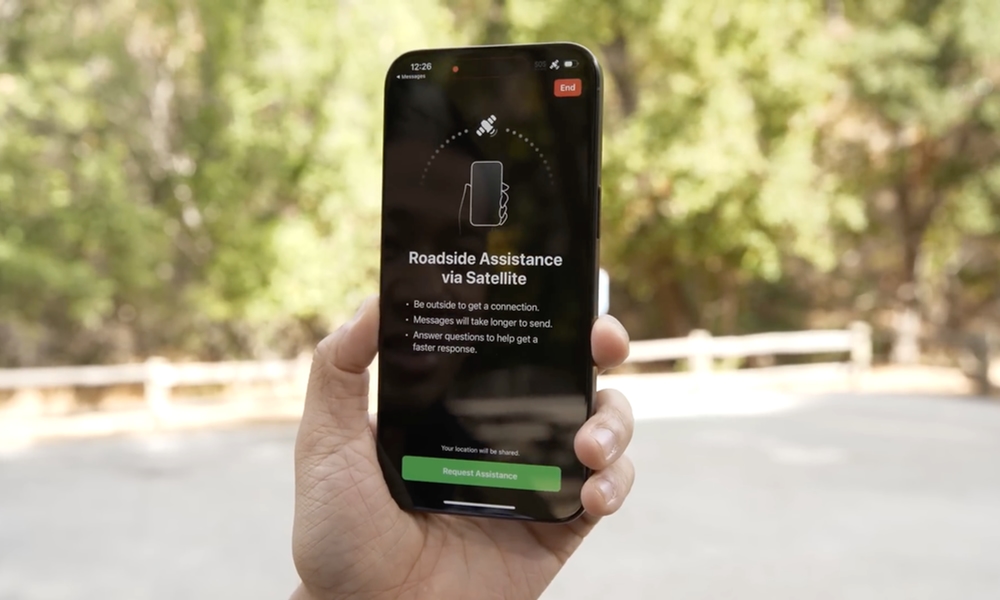You Can Now Get Apple’s Roadside Assistance from Verizon via Satellite
 Credit: Brian Tong / YouTube
Credit: Brian Tong / YouTube
Toggle Dark Mode
Apple’s Roadside Assistance via Satellite feature, which is compatible with the iPhone 14 and iPhone 15 handsets now works with the Verizon Roadside Assistance program, according to an updated Apple support document.
With the release of iOS 17.2, Verizon customers in the US who have an iPhone 14 or iPhone 15 can use the Roadside Assistance via Satellite feature to contact Verizon’s roadside assistance program.
The new Verizon option joins the AAA roadside assistance that Apple unveiled alongside the debut of iOS 17 earlier this year.
Verizon subscribers have the option to purchase Roadside Assistance for $4.99 per month for each line the subscriber has on their account. Verizon’s program provides fuel delivery, battery jumpstart, winching, towing, tire changes, and more, with set limits on all services.
Verizon’s Roadside Assistance generally allows four service claims in the provider’s wireless coverage area, limiting assistance to one claim outside of its wireless coverage. However, Verizon says that non-coverage area service requests are only available to iPhone 14 and iPhone 15 models running iOS 17.2 or later.
Roadside Assistance from the provider is also available on a pay-per-use basis for Verizon customers who didn’t opt to subscribe to the service. The monthly subscription price is a bargain when compared to the pay-per-use fee. Towing begins at $154, a jump start is $92, and a tire change will run $98.
Apple’s Roadside Assistance via Satellite debuted with the iPhone 15 models earlier this year as an expansion of the Emergency SOS via Satellite feature that landed with the iPhone 14 in 2022. Apple doesn’t handle roadside assistance in-house but merely provides satellite communications to route customers to Verizon or AAA.
Emergency SOS via Satellite allows iPhone 14 and iPhone 15 users to send text messages to emergency services using satellite connectivity when they are out of the reach of cellular and Wi-Fi coverage. Users can also share their location via satellite by using the Find My app.
The service works over text message communications, rather than voice, and can send and receive messages as quickly as 15 seconds under ideal conditions with a direct line-of-sight to the sky. Users are prompted to complete a short questionnaire to provide vital information at the start of the call so emergency services has everything needed to dispatch help as quickly as possible. The interface then guides the user to point their iPhone to an appropriate satellite to connect and send their message, which includes the information the user provided along with their geographical location, altitude, the iPhone’s remaining battery charge, and the user’s Medical ID info if available.
In addition to Emergency SOS via Satellite and Roadside Assistance via Satellite, Apple also offers other safety features to assist iPhone users in their time of need:
- Users can share their location via satellite by opening the Find My app to inform friends and family of their whereabouts if they are traveling off the grid.
- Crash Detection detects severe car crashes and automatically diales emergency services if the iPhone user is either unconscious or unable to reach their iPhone.
- Users can automatically notify friends and family that they have reached their destination safely via Check In.
- Users can set up their Medical ID information in the iPhone Health app to aid first responders in accessing medical information from the Lock Screen without requiring a passcode.
Apple provides two years of satellite communications features at no additional charge when you purchase an iPhone 14 or iPhone 15; an offer it recently extended by another year for those who purchased an iPhone 14 before November 15, 2023 — the one-year anniversary of when Apple’s satellite services officially went online.
Although Emergency SOS via Satellite doesn’t carry any extra fees right now and is available in 16 countries and regions around the world, Roadside Assistant via Satellite is limited to the United States, and those who want to take advantage of it will need to be members of a roadside assistance program or be willing to incur pay-per-use fees to AAA or Verizon to take advantage of their services.







